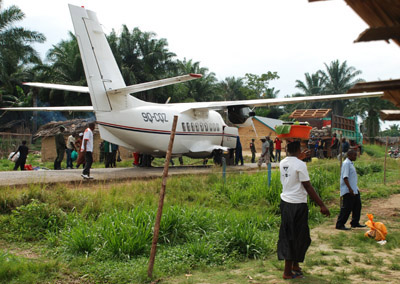
WALIKALE, Democratic Republic of Congo — The paradox of Congo – ruin caused by years of war and poor governance amid enormous potential wealth – is a common theme when describing the challenges the country faces. But perhaps nowhere is the contradiction of utter lack of development amid abundant natural resources more pronounced than in Walikale, an isolated region in conflict-plagued eastern Congo.
To get here, you have to fly. Commercial flights (questionable in terms of safety but the most frequent) make trips from Goma several times a day, carrying supplies into Walikale and minerals out. The dilapidated Russian planes were once meant for passengers; now the row of windows is boarded up, the seats removed to make a large open space for cargo. A single line of seats behind the cockpit can accommodate three or four passengers; others perch on the cargo in the back.
As the plane banks in for landing, a stretch of paved road appears as the lone open space surrounded by dense jungle. Motorbike drivers line up for hire, and people emerge from their huts mildly curious to see what the plane has brought in. The only vehicle around is a vintage lorry waiting on the ‘runway,’ its bed piled with bags of cassiterite. Plenty of well-armed soldiers mill around to see the valuable cargo off, and a few help push the plane around so its nose aims back down the straight part of road. After 30 minutes or so, the shipment of raw minerals is headed back to Goma.
Before President Kabila instituted the ban on mining, 17 to 20 tons of cassiterite were flown out of Walikale each day, according to official records kept by government’s mining administration – though the actual quantity likely exceeded this figure. The head of a comptoir in the town of Ndjingala at the entrance to Bisie, the region’s largest mine, told Enough that one kilogram of cassiterite fetches $1.50 to $3 here ($5 before the ban), compared to $20 in Kigali.
“If mining here was industrialized, we could mine at Bisie for a hundred years,” said Muhima Dieudonné, the head of SAESSCAM, the small-scale mining technical assistance and training service, in the trading town of Mubi. And if artisanal mining continued? “It would last forever,” he said.
Those figures may not be so precise, as no company has ever commissioned an assessment of the reserves at Bisie. But a European mining executive said that Bisie alone contains enough reserves to warrant building a smelter in Walikale. In addition to cassiterite, the mine has ample quantities of copper and cobalt.
“Walikale is famous for all it has – look, you come from Washington to see Walikale. But look at how we have nothing here,” said Bwami Muputa, the head of a motorbike transport company. Muputa’s office is in the center of town, situated on the dusty main roundabout where three roads jut off to Goma, Kisangani, and Bukavu – at least in theory. But the roads are virtually impassable. The one toward Kisangani was partially paved during the Mobutu era and now nearly connects Walikale town to Ndjingala. But from Ndjingala to Bisie mine is a day-long trek on foot for those accustomed to the terrain. (We were told we would likely have to spend the night on the trail if we attempted the journey.) Asked how long it took to drive his motorbike from Goma when he first bought it, taxi driver Kotiko said his bike came on a plane.
The town has no hospital; houses are built of mud and palm fronds. School is held in decaying colonial-era buildings that appear to be at risk of collapsing. Expensive generators provide electricity. Manioc and plantains grow in small plots on the hills around town, connected by narrow dirt footpaths, and many people walk home in the evening carrying small plastic bags of tiny fish from the river that runs through town. But much of Walikale’s food comes via Goma.
People have stopped cultivating because they are only focused on mining, said a local immigration officer. He acknowledged that it’s a dangerous trend in an isolated territory to be so dependent on basic supplies coming from outside, but he said that shifting to a more long-term outlook is difficult when people are focused on making ends meet day to day and keeping an eye out for some small way to get ahead.
“Do you think someone could buy a motorbike like this, at $1,500? Or build a house like that, just from cultivating? Impossible,” said Kotiko as he drove his motorbike taxi past one of the nicest buildings in town.
“Because this area is landlocked, there is no alternative livelihood. We have to go to the mines,” said Ramazani Molisho, a miner.
Under the current system, where companies pay off local officials and army and militia commanders to gain access to mines and then ship their minerals directly out, mining companies have little incentive – and certainly no government-imposed requirement – to develop the local communities. Since the industry here has always operated in this ad hoc way, people have learned to gain what little benefit they can. After President Kabila’s mining suspension made livelihoods even more precarious, people have begun to reflect on the pre-ban business – abysmal though it was – longingly.
Bwami Muputa, the head of the transport company, was surrounded by at least 20 of his sometime-employees, sometime-miners as he explained the irony of this place. He put it simply: “Walikale relies on minerals, but it is killing people.”
Fidel Bafilemba contributed to this post.
Photo: A truck loaded with cassiterite pulls up next to the plane bound for Goma (Enough/Laura Heaton)

